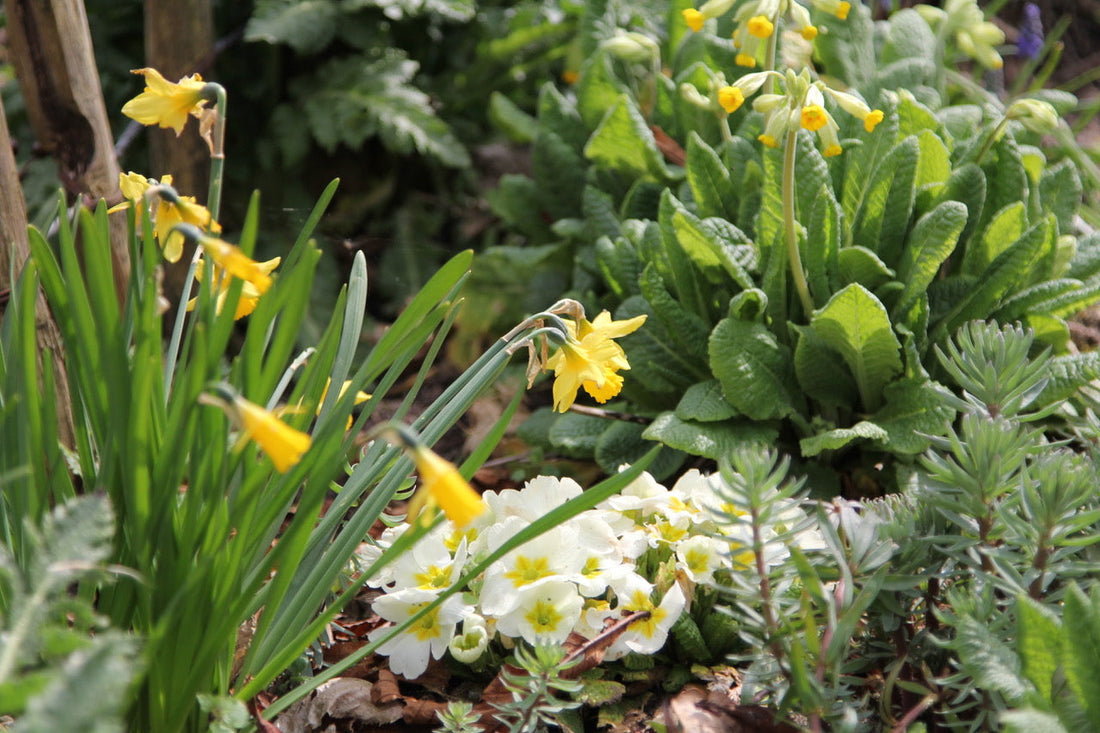Perennials and bulbs
Bulbs and perennials can delight us with their diversity and abundance of blooms almost year-round. Svenja Schwedtke from the Bornhöved Perennial Nursery explains how to best combine these "beautiful" plants.

Stars of the season
If we start with the regular bulbs planted in the fall, there's a very wide range, from winter aconites, snowdrops, wild crocuses, and snowdrops that bloom very early in the year, to ornamental alliums that bloom from May to June/July. The very early ones are a delight in a still-bare garden simply by their very presence—because something is finally blooming again! They are also beautifully accompanied by other early bloomers, such as cyclamen, primroses, lungwort, and sweet violets.
March to May is the peak season for tulips and daffodils. Since these plants retain their foliage for quite some time after flowering, which gradually turns yellower over time and should only be removed when it's completely brown (to ensure the bulbs retain nutrients!), clever combinations are required.
Cleverly combined
It makes sense to plant perennials next to daffodils and tulips. Their leaves initially provide a good background or substrate, then their lush foliage conceals the yellowing leaves, and later delights with their own blooms. For example, it's great to plant early and late daffodils next to hostas. The pair complement each other wonderfully. They sprout relatively late, but their large leaves nicely conceal the retracting foliage of the daffodils while still allowing enough light to penetrate for assimilation. Both have similar site requirements; many daffodils prefer soil that's a bit heavier and richer, which hostas also like.
Star appearance with airs
Tulips in the garden are a bit more demanding. First of all, they absolutely need frost to bloom at all, and they also prefer very dry summers. So, if you want to do something good for tulips, plant them next to other perennials that prefer dry conditions in summer, preferably in well-drained soil. If the tulips are planted in rich soil next to showy perennials that may even be watered in summer, it's usually too moist for them, and the better alternative is to dig them up after they bloom. A magical composition with one of my favorite tulips consists of the spurge species Euphorbia amygdaloides or dulcis 'Chamaeleon' and dark-leaved Heuchera (Heuchera 'Cocktail') with the orange-red lily-flowered tulip 'Ballerina'. Or the wonderful viridiflora tulip 'Spring Green' (white with a touch of green) with lady's mantle, emerging daylilies, and perhaps white horned violets...
One method that works very well is to grow tulips (this also works wonderfully with daffodils) in pots, bowls, or tubs. You can move these to the right spot when the tulips are in full bloom. And once they're finished flowering, simply move the pot a little further back. This way, you can also keep the problem of summer drought under control!
A great idea
Why not try this idea: Fill a large tub, such as half a wine barrel, three-quarters full with soil at planting time in the fall. Plant tulip bulbs tightly together, cover with soil, and plant horned violets on top. Horned violets survive the winter (if it's really freezing, perhaps cover them with some fir). This will create a wonderfully established, colorful display early in the spring. The tulips will simply push through and be the next blooming highlight! This will stay beautiful until the end of May, when summer flowers can be planted.
Colorful flower balls
The next round of bulbous flowers in the garden begins in May with the early ornamental onion varieties: 'Purple Sensation' is one of my favorites because of its vibrant purple flower balls that bloom from May to June on sturdy, 90 cm tall stems. Due to the abundance of varieties, ornamental onions can be enjoyed throughout the early summer season: The very large globes ('Globemaster') come next, followed by 'Allium giganteum'. These large varieties usually no longer have such attractive foliage during flowering—the foliage should be hidden among flat, "tangled" vegetation such as speedwell or lady's mantle.
The giants among garden flowers
Since baubles often come with candles, Eremurus are good companions for the various ornamental onions. Their blossoms, which can reach up to 2.5 meters in height, are guaranteed to be noticed. Eremurus are the tubers that look like octopuses, with long "arms" extending radially in all directions. They should be planted about 15 cm deep. Just like ornamental onions, the soil should be permeable for Eremurus. They thrive best in sunny and warm locations. Eremurus sometimes doesn't bloom for two or three years after planting. This is often due to the often mild winters; they absolutely need frost to bloom! Planted in large numbers, the ornamental onions hop through sunny beds and, together with the Eremurus, create accents above the rock roses, geraniums, and gypsophila. Feel free to plant these inexpensive bulbs in large quantities; you'll be amazed by the effect: They create a picture-perfect garden! Planting different varieties of ornamental onions in a large area with a perennial variety, such as catnip, also creates a unique garden.
TEXT: Svenja Schwedtke












